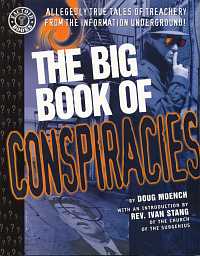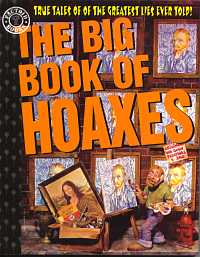BIG BOOK OF... REVIEWS
It seems to me that gonzo fans gravitate towards three
areas: conspiracy theories, hoaxes and comic books. Don't
laugh, it's true. There's no reason why gonzo fans won't
like The Big Book of Conspiracies or The Big Book of Hoaxes
published by Paradox Press. There's no reason either why
they wouldn't enjoy the other titles in this series from the
DC comics imprint, such as ...Urban Legends, ...Death,
...Martyrs, and ...Weirdos.
Billed as cheaper and more fun than a college education,
these books combine fact with comic book art in a unique
way. The book may be authored by a single person, but each
story is illustrated by a different artists, most of them
instantly recognizable from the DC fold. Each story is two
or three pages long and the books are in black and white.
These two titles, however, are my utmost favourites, and
decently priced at $14.95US and $20.95Cdn.

Conspiracies is written by Doug Moench,
author of the graphic novel Bloodstorm and
The Big Book of the Unexplained (also highly recommended!). The introduction is
by the Reverand Ivan Strang of the Church of the Subgenius.
Besides the usual JFK and UFO conspiracy theories (including a story
about "the other Oswald"), Moench manages to dig up the more
unheard of conspiracy theories - for example, two stories
each on the death of Jim Morrison and whether or not the
1969 moon landing was a real event. Other stories seem drawn
directly from The X-files, such as post-war Nazi and CIA
relations and the face on Mars.
My favourite stories are "Gal Killin'", about the strange
death of Dorothy Kilgallen who was set to tell the story of
Jack Ruby; and "Saucer Sorcery", which explores the UFO links of
Aleister Crowley, L. Ron Hubbard and Nazis. "Pyschadelic CIA"
is probably the coolest one, about CIA experiments with LSD.
Some of the more obscure conspiracies are not so
far-ranging, such as a murder aboard William Randolph
Hearst's yacht and a cursed church in France.
Conspiracies is the kind of book that makes you
wonder...what if it's all true? Moench's light, cheeky tone
goes well with most of the illustrations. For example, the
demonic art of "Killing Castro" gives his words a meaning
all their own! Whether or not you swear by official
versions, this book will have you questioning the news a
little more.

Hoaxes, on the other hand, is much more loony, written by
Carl Sifakis. Again, it's filled with hoaxes most probably
don't know about - or perhaps heard by word of mouth.
As the cover says, "True tales of the greatest lies ever told!".
Gonzo fans all know how fun a good hoax can be - for
example, half-truths and doomed tricks fill Campaign Trail -
and two years ago, he was the subject of an
internet death hoax. Unsurprisingly, newspapers and journalists are
responsible for most of the stories in this book.
From art forgeries (the guaranteed fakes of Alceo Dossena)
to the eigthteenth century bunny mother, Sifakis searched far
and wide to bring a broad range of stories together. More
importantly, readers can easily see how people are easily
manipulated by what the media offers them, such as Lou
Mortison's ingenious (but non-existant) farmer Lester Green
or Orson Welles' "War of the Worlds". In fact, one prank by
four journalists in Denver actually started the Boxer
Revolution in China. Like most hoaxes in this book, they
never intended their lie to go that far.
Perhaps no one unwittingly went farther than Janet
Cooke. Her story about Jimmy, the eight year old heroin
addict won the Pulitzer Prize, even though the editors at
the Washington Post had doubts about its authenticity. The
award was retracted and Cooke now works in a clothing
store. In fact, she never even was a real journalist - her
resume was made up - which makes one wonder about the fact
checkers at the Post.
And of course, no book with phony journalism would be complete
without the father of yellow journalism - William Randolph
Hearst :-) who appears in three stories. Come to think of it,
most of the stories in here are about literary hoaxes, such
as the killer hawk of Chicago, David Rorvik's book about
cloning called In His Image and the famous Dreadnought Hoax
in which Horrace Cole and Virginia Woolf and three friends
pretended to be foreignors from an exotic country, fooling British admirality.
Some of the more
bizarre hoaxes are absolutely delightful - like Mary Toft,
who fooled royal doctors into thinking that she had been
impregnated by a "six-foot lecherous looking" rabbit. All it
took was a bunny to pop out from under her skirt and all doubt was cast aside.
"The Possessed Nuns of Loudun" is by far my favourite piece.
It began as a way to get rid of a particularly debauched
priest whom Cardinal Richelieu despised. It was said that
the priest had made a pact with the devil and eventually
both the nuns and villagers of Loudun used "the devil made
me do it" excuse. Of course, it was only the nuns who were
being bribed by the Cardinal, even after the priest was put
to death. When the Cardinal decided that their manic dances and other
fits of possession couldn't go on any longer, he stopped
paying them. I don't know if it's the illustrations or the
humor of mass hysteria that makes this one stand out for me.
Either volume is a nice addition to any collection of books,
the authors having given the medium the respect it deserves
and expanding the many creative ways in which people tell
stories.
LOL lest one suspects me of working for DC, who also
has the imprint of Vertigo Comics which publishes Transmetropolitan,
I don't.




